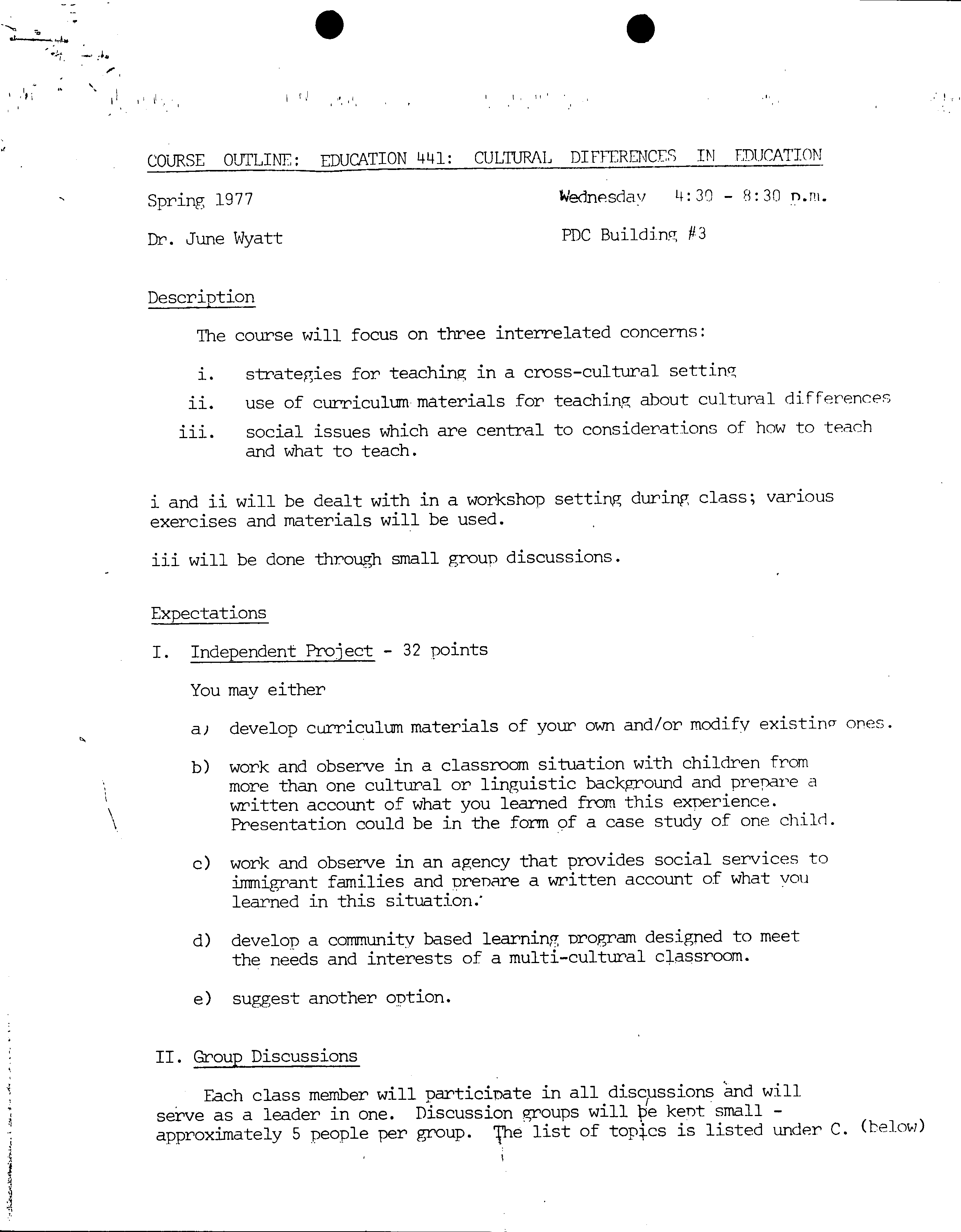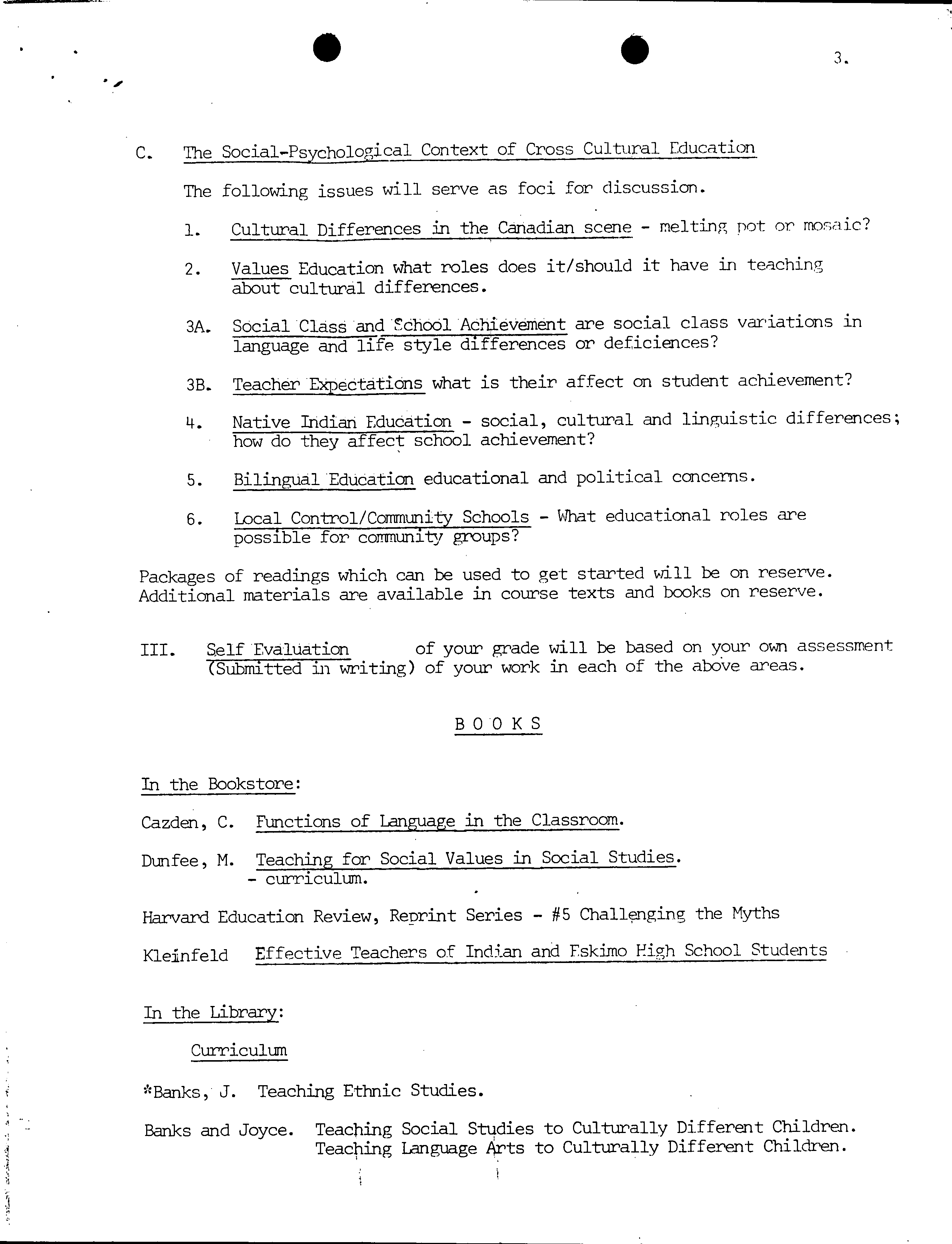COURSE OUTLINE: EDUCATION 4
p
41: CULTURAL DIFFERENCES IN EDUCATION
Spring 1977
?
Wedne.sdav
?
L:30 - 8:30 n.m.
Dr. June Wyatt
?
PDC Building 93
Description
The course will focus on three interrelated concerns:
i.
strategies for teaching in a crass-cultural setting
ii.
use of curriculum materials for teaching about cultural differences
social issues which are central to considerations of how to teach
and what to teach.
i and ii will be dealt with in a workshop setting during class; various
exercises and materials will be used.
iii will be done through small group discussions.
Expectations
I. Independent Project
.
-
32 points
You may either
a, develop curriculummaterials of your own and/or modify existin
g
ones.
b)
work and observe in a classroom situation with children from
more than one cultural or linguistic background and prepare a
written account of what you learned from this experience.
Presentation could be in the form of a case study of one child.
c)
work and observe in an agency that provides social services to
immigrant families and nrenare a written account of what you
learned in this situation.
d)
develop a community based learning nrogram designed to meet
the needs and interests of a multi-cultural classroom.
e)
suggest another option.
II. Group Discussions
Each class member will particinate in all discussions and will
serve as a leader in one. Discussion groups will be kent small -
approximately 5 people per group. The list of topics is listed under C. (below)
H.
Format
A. As discussion leader you are responsible for
1.
Seeking out different points of view expressed in the readings
2.
Formulating discussion questions based on readings
and making sure that members of the group have these at least
one week before the discussion
3.
Assigning readings to discussion group
members at least one
week before the discussion
. Directing the discussion
S. Writing up a report on the discussion
Criteria for Evaluating Retort (worth 32 points)
1.
Clarity of writing, organization, presentation.
2.
Clarity in focussing on and highlighting issues. (The
report is not a series of "book reports" or summaries but
an analysis of the ways in which readings and discussions
highlight issues).
The report should not exceed eight cages and should include:
1.
The questions you used to guide discussion with an explanation
of why you formulated these questions.
2.
A statement of the issues, you should report not only on what
happened in the discussion group but your own analysis of the
issues.
3.
A statement of different points of view as expressed in the
readings. Refer sDecifically to readings..
B. As discussion participant you are responsible for:
1.
Doing readings assigned by leader.
2.
Handing in a-qoto' three page written account of each discussion
(6 points per account) in which you describe the main issues
dealt with, what you read and how it related to what others
read. Total 36 points.
. ?
.
C. The Social-psych ological
Context of Cross Cultural Education
?
The following issues will serve as foci for discussion.
1.
Cultural Differences in the Canadian scene - melting
pot
or mosnic?
2.
Values Education what roles does it/should it have in teaching
about cultural differences.
3A.
SOcial Class and $dhbbl AbhiéVniént are social class variations in
language and life style differences or deficiences?
3B.
Teacher Epedtätibns what is their affect on student achievement?
. Native Indian Education - social, cultural and linguistic differences;
how do they affect school achievement?
5.
Bilingual Education educational and political concerns.
6.
Local Control/Community Schools - What educational roles are
possible for community groups?
Packages of readings which can be used to get started will be on reserve.
Additional materials are available in course texts and books on reserve.
III. Self EvalUation
?
of your grade will be based on your own assessment
(Submitted in writing) of your work in each of the above areas.
BOOKS
In the Bookstore:
Cazden, C. Functions of Language in the Classroom.
Dunfee, N. Teaching for Social Values in Social Studies.
- curriculum.
Harvard Education Review, Reprint Series - #5 Challenging the Myths
Kleinfeld Effective Teachers of Indian and Eskio High School Students
In the Library:
fli
1flfli ri ill ITfl
Banks, J. Teaching Ethnic Studies.
Banks and Joyce. Teaching Social Studies to Culturally Different Children.
Teaching Language Arts to Culturally Different Children.
.
?
n
?
4.
Alberta Elementary Social Studies Handbook: Experiences in Decision
Making.
Raths, Hanriin, Simon. Values and Teaching.
Shaftel, Fanny and George. Role Playing for Social Values.
Taba, Hilda. *Teaching Strategies for the Culturally Disadvantaged.
A Teache'HandbOok for Elementary Social Studies.
Curriculum Development: Theory and Practice.
General:
Ashworth, Marty
?
Irrniigrant Children and Canadian Schools
Good and Brophy
?
Looking in Classrooms.
Martell, G.
?
Politics of the Canadian Public School
Palmer, Howard, ed.
?
Immigration and The Rise of Multiculturalism
Rosenthal.
?
Pygmalion in the Classroom.
Ryan, T.
?
Poverty and the Child: A Canadian Study.
Hodgetts. ?
What Culture, What Heritage?
Krauter, Joseph
?
The Other Canadians: profiles of six minorities.
Minghi, Julian.
?
Peoples of the Living Land (studies of
ethnic groups in B. C.)
Lambert, W.E.
?
Bilingual Education: The St. Lambert Experiment
Swain, M.
?
Bilingual Schooling: Some Experiences in
Canada and the U. S.
Journals
Canadian Ethnic Studies
Vol. VII No.1, 1975
?
Special Issue: The Green Paper
on Immigration
Vol. VIII No.1, 1976
?
Special Issue: Education and Ethnicity
. ?
I
COURSE CALENDAR
EDUCATION
Snring 1977
I. January 12
Class mechanics, classroom strategies
Vancouver multi-cultural resources field trip.
II.
January 19
Guest resource persons: The Multicultural Resource Team
III.
January 26
Report back on field exercise
Discussion: Melting Pot or Mosaic
Film: ?
This is a Photograph
IV.
February 2
Field Trip: Social Service agency to be announced
V.
February 9
Field trip follow up
Classroom strategies: Diplomat simulation
Social Studies materials
Video Tape: How to Read a Foreigner
VI.
February 16
Discussion: Values/Moral Education
Films: ?
Bill Cosby on Prejudice, Balablok
VII.
February 23
Discussion: Social Class and School Achievement or Teacher Expectations
Film: ?
Eye of the Storm
VIII.
March 1
Discussion: Indian Education
Film: ?
Bella Bella
. ?
I ?
2.
IX.
March 8
Discussion; ?
Bilingualism
Resource Person
X.
Maróh 15
Open to class decision
(Film: Enemy Alien)
XI.
March 22
Discussion: Local Control
Guest Resource person - community schools
XII.
March 29
Discussion: Canadian Cultural Materials
Cross Cultural Simulation
Film: Hutterites
XIII April 5
Course Evaluation
Sharing projects
.,..-- .- ?
....,.',
indicates that ITerial is available in hooksto
RFPJ)iN(S
1.
II.
Melting Pot or Mosaic?
New Canadianism
Indian Schools for Indian Children
The Cultural Contributi
o
n s
of Other
Ethnic Groups
Indian Immigration and Racial Prejudice
Social Change and Problems of
Education in Canada
Hutterites
Eight Newspaper articles
Values Education/Moral Education
Loren Lind
Alex Sim
Royal Commission
Kermal Singh Sandhu
John Porter
Hostetler
de Villiers, Smith,
Peterson, Cbandi,
Sarti, Ahrnopou los,
Calgary Herald, Suzuki,
Braddock, Lifestyles.
Face of Fear: Racism in Canada
?
Marq de Villiers
Fear and Loathing in the Canadian
?
Collins, Doug
Mosaic
Children of Protest (Doukhobors)
?
Cameron
"East Indian term arouses Critics"
?
Wyng Chow
Prejudice and the Immigrant Child
?
David Milner
"Flannel-mouthed Bigots"
?
Calgary Herald
"Another Perspective" ?
David Suzuki
All of the above are in folder on Melting Pot or Mosaic
Moral Education
Values and Teaching
The Child as Moral Philosopher
Role Playing for Social Values
Intergroup Education
Teaching for Social Values in Social
Studies
III.A Social Class and School Achievement
Early Childhood Intervention (HER)*
Deficit, Difference and BiCultural
Models (HER)*
Some Performances and Prospects
Canadian Intervention Programs
School Performance and Social Class
What Children Can Do
Cultural Deprivation: Euphemism
and Essence
Teaching Disadvntaged Children in
the Pre-School chapter 1 and 2
Phi Delta Kapan
Raths, Harmin F, Simon
Kohlberg
Shaftel
Grainbs
Dun fee
Baratz
Valentine
Frederick Williams
Ryan
Ryan
Kagan
Das
Bereiter
., ?
.
4
?
I
?
L]
?
2.
A Successful Compensatory Educational
Model
A Critique of Compensatory Education
III. B Téächer Expectations
Teacher Expectations
Student Social Class and Teacher
Expectations in Harvard
Education Review'*
Pygmalion in the Classroom (on
reserve)
(preface Chapter 1, 5, 12).
Effective Teachers of Indian and Eskimo
High School Students
IV. Native Indian Education
Functions of Language in the Classroom
Canadian Indians
Culture and the American Indian Community
Orientation Class
V.
Bilingual Education
Research in Bilingual Education
Ethnicity and School Adjustment
Perspectives on Bilingual Education
in Canada
"Why the Bilingual Education .. ."
Toronto Trustees Urge Bilingual
Instruction
Use of Chinese language in schools urged
VI.
Local Control
The Case for Community Control of the
Schools
What Rough Rock Demonstrates
Community Schools
Indian Control of Indian Education
Training Teachers for Inner City Schools
(HE)
VII. Canadian Cultural Idéntit
The Gross National Ignorance
What Culture What Heritage
From Pilgrims Progress to Sesame Street
Canadian Literature: The Necessary
Revolution
Canadian History in Public Schools
Stenner
Bernstein
Good and Brophy
Ri St
Rosenthal F, Jacobson
Kleinfeid
Articles by Boggs, John,
DuMont and Phillips
Lane
Rosenthal
King
Homer
King
McNamara
Cranston
Sallot
Vancouver Sun
Loren Lind
Erickson and Schwartz
Stevens
Cuban
Hurtig
Hodgetts
Repo
Mathews
Dewar
• ?
••








